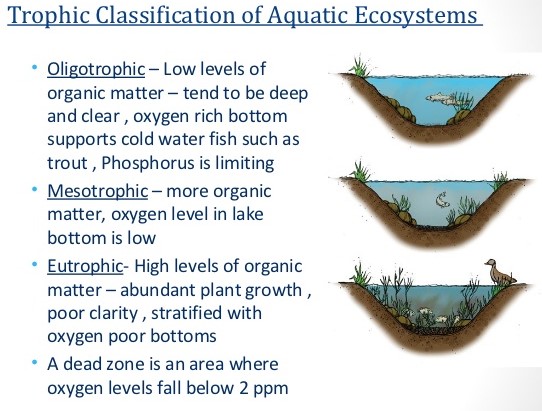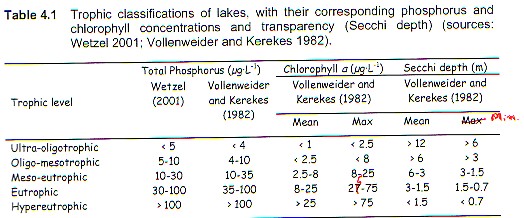
Disclaimer & Copyright Notices; Optimized for the IE & Firefox

| Limnological characterisation | Oligotrophic | Mesotrophic | Eutrophic |
|---|---|---|---|
| General level of production ........ | low | medium | high |
| Biomass ............ | low | medium | high |
| Green and/or blue-green algae fractions | low | variable | high |
| Hypolimnetic oxygen content ..... | high | variable | low |
| Impairment of multi-purpose use of lake | little | variable | great |

Trophy, then, is an expression of the combined effects of
organic matter to the lake. As developed originally and as largely used
today, the trophic concept (e.g., TP, Cha, SD, and TN) refers to the
pelagic-zone-planktonic portion of the lake ecosystem (cf.
Tables 4.1 and 4.2,
CCME & EC, 2004).
The littoral flora and its
often dominating supply of autochthonous organic matter to the system,
was, and usually still is, ignored. Prof. Dr. Bob Wetzel
was a recipient of numerous awards in limnology, biology, and ecology
among which were the Naumann-Thienemann Medal, the top
medal in limnology, and the Hutchinson Award.
 "Trophy of a lake refers to the rate at
which organic matter is supplied by or to the lake per unit time."
"Trophy of a lake refers to the rate at
which organic matter is supplied by or to the lake per unit time."
Trophic State Classification of Lakes with Aquatic Macrophytes (Canfield et al., 1983), and Assessing the Trophic Status of Lakes with Aquatic Macrophytes (Canfield and Jones, 1984):- "Conventional criteria for classifying trophic state emphasize conditions in the open water and ignore the nutrients, plant biomass, and production associated with macrophytes. A potential water column nutrient concentration can be determined through adding the nutrients contained in macrophytes to those in the water. Potential nutrient concentrations can be used in existing indices to classify lake trophic status."
![]() Vollenweider's dictum re
the OECD Probability Distribution Diagrams:
Notwithstanding the trophic state classifications based on pelagic
parameters, listen to a 4-minute mp3 sound file of
Dr. Richard Vollenweider promoting the use of the OECD probability
distribution diagrams in order to establish trophic states with a
high confidence level.
Vollenweider's dictum re
the OECD Probability Distribution Diagrams:
Notwithstanding the trophic state classifications based on pelagic
parameters, listen to a 4-minute mp3 sound file of
Dr. Richard Vollenweider promoting the use of the OECD probability
distribution diagrams in order to establish trophic states with a
high confidence level.
Dr. Richard Vollenweider was a recipient of the top medal in limnology, the Naumann-Thienemann Medal, among several other awards.
*We thank all the sources for the info
We salute the Chebucto Community Net (CCN) of Halifax, Nova Scotia, Canada for hosting our web site, and
we applaud its volunteers for their devotion in making `CCN' the best
community net in the world!